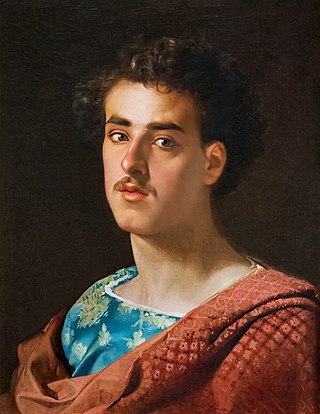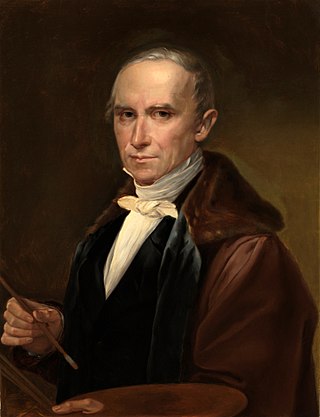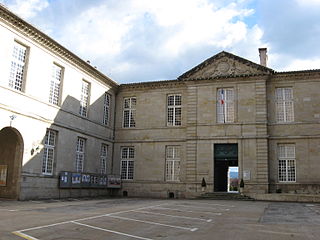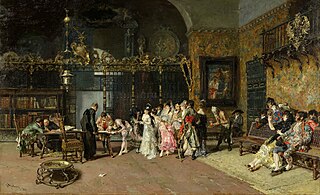Related Research Articles

Marià Josep Maria Bernat Fortuny i Marsal, known more simply as Marià Fortuny or Mariano Fortuny, was the leading Spanish painter of his day, with an international reputation. His brief career encompassed works on a variety of subjects common in the art of the period, including the Romantic fascination with Orientalist themes, historicist genre painting, military painting of Spanish colonial expansion, as well as a prescient loosening of brush-stroke and color.

Federico de Madrazo y Kuntz was a Spanish painter.

Raimundo de Madrazo y Garreta was a Spanish painter from the Madrazo family of artists who worked in the Realistic style, although his later work shows signs of Rococo and Japanese influence. He was known primarily for his genre paintings and portraits. His grandfather was José de Madrazo, his father was the portrait painter Federico de Madrazo and his brother was Ricardo de Madrazo.

José de Madrazo y Agudo was a Spanish painter and engraver; one of the primary exponents of the Neoclassical style in Spain. He was the patriarch of a family of artists that included his sons Federico and Luis; and his grandsons, Raimundo and Ricardo.

Eduardo Zamacois y Zabala was a Spanish Academic painter who specialized in small-scale canvases. He was the father of the French writer Miguel Zamacoïs, brother of the writer Niceto de Zamacois, the singer Elisa Zamacois and the actor Ricardo Zamacois, and also an uncle of the writer Eduardo Zamacois and the music composer Joaquín Zamacois.

The Goya Museum is an art museum located in Castres, France. The museum was originally established in 1840 and was named after the Spanish painter Francisco Goya since it specialised in hispanic art from 1947.

The Spanish Wedding or La Vicaría (1868–1870) is a masterwork by Marià Fortuny i Marsal, also known as Marià Fortuny or Mariano Fortuny. La Vicaría exemplifies genre painting of the 19th century. The use of jewel tones, contrasts between light and dark, and the virtuosity of the work attest to Fortuny's talent. It resides at Museu Nacional d'Art de Catalunya in Barcelona, Spain.

Juan Antonio Ribera Fernandez, also Juan Antonio de Ribera was a Spanish painter.

Luis de Madrazo y Kuntz was a Spanish painter of portraits and religious scenes from a well-known family that included his father José, and his brothers Federico, Pedro and Juan. His Polish grandfather Tadeusz Kuntze was a painter as well.

José Villegas Cordero was a Spanish painter of historical, genre and costumbrista scenes.
Events in the year 1920 in Spain.

Federico de Madrazo y Ochoa was a Spanish painter working mostly in and around Madrid, although he also spent some time in Paris.

Ricardo Federico de Madrazo y Garreta was a Spanish painter from the Madrazo family of artists, best known for his Orientalist works. He was also the brother-in-law of the great Spanish Orientalist, Mariano Fortuny, who would be a major influence on both his life and work.

Pedro de Madrazo y Kuntz was a Spanish painter, jurist, writer, translator and art critic.

Juan de Madrazo y Kuntz was a Spanish architect and restoration expert.

Cecilia de Madrazo y Garreta was a collector of textiles. She was married to the famous Spanish artist, Marià Fortuny.

Ricardo Villodas y de la Torre was a Spanish painter; best known for his classical and historical scenes.
References
- ↑ German & Carmen Inc. garcia2021
- ↑ LegacyBook:El German y Carmen Madrazo de Tetuan, Ciudad de Zamboanga by El Shelico 2022
- ↑ LibrodeAppelidos1890
- ↑ Heráldica de Cantabria (in Spanish) Archived 2010-04-03 at the Wayback Machine
- ↑ Los Madrazo, una familia de artistas: [Exhibition], Museo Municipal, 1985 [catálogo de la exposición, tapa del libro]
- ↑ Caso, E.D., Les Orientalistes de l'école Espagnole, ACR edition, 1997, p. 158